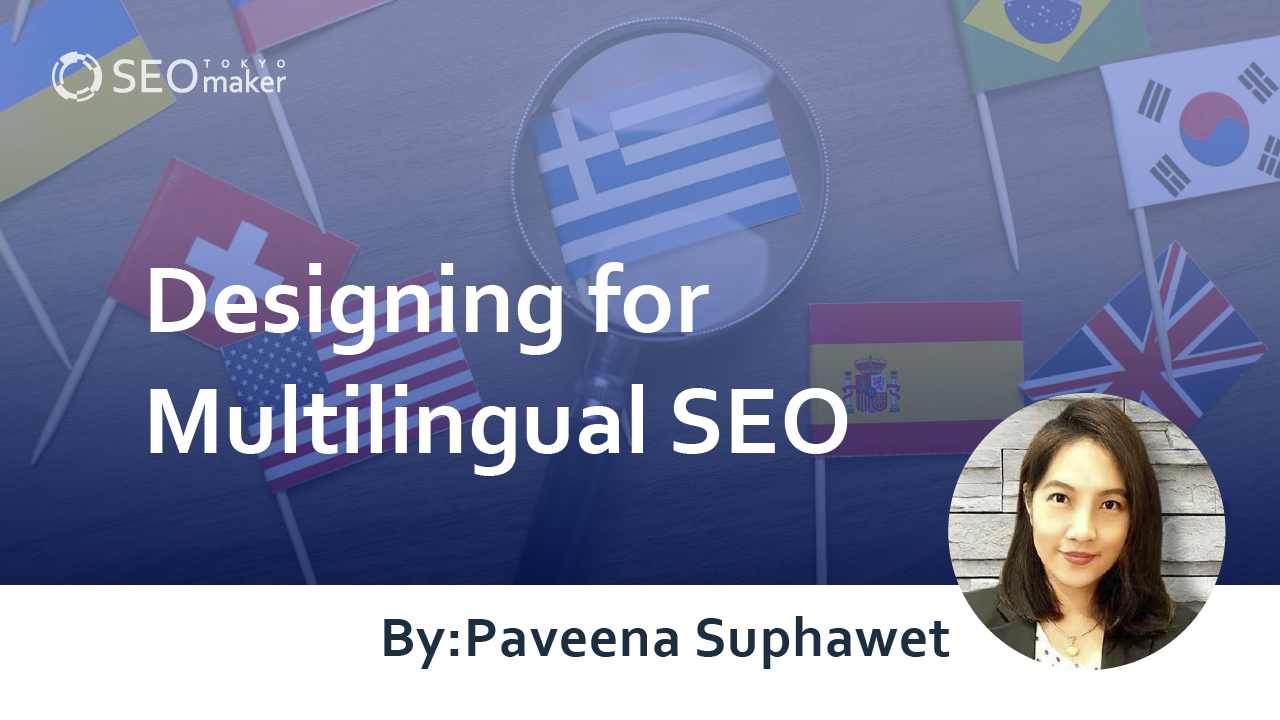Designing for Multilingual SEO : Explaining Points when Creating
contents

With the internet’s global reach, even Japanese companies can easily expand overseas. However, SEO success in Japan does not guarantee success abroad.
Language barriers are just the beginning; implementing multilingual SEO strategies is crucial. While the technical aspects of multilingual SEO aren’t overly complex, focusing on local customs, culture, and incorporating native insights into site creation is vital. Careful human translation is a key factor in the success of multilingual SEO.
This guide covers essential points and precautions for successful multilingual SEO, useful for companies considering international expansion. Check out our tips here on overseas SEO as well .
Multilingual SEO
Multilingual SEO involves optimizing your site for multiple languages, not just Japanese.
While standard SEO practices involve creating content only in Japanese, companies looking to expand abroad or target inbound tourists must optimize their content in other languages as well.
Launching a site without understanding multilingual SEO can lead to issues like inappropriate domain or server choices or relying solely on machine translations for content, leading to potential problems.
Why Multilingual SEO Is Important
When contemplating international expansion, how you present your services is a critical business decision. Online customer acquisition is crucial, necessitating the creation of websites in the local languages.
However, entrusting site creation to a company that doesn’t understand SEO might result in merely translating a Japanese site into English or Chinese, which often isn’t effective.
Failing to consider languages and countries in site creation and SEO strategies can lead not only to ineffectiveness but also to unnecessary complications.
Moreover, while Google is well-known in Japan, other search engines may dominate in foreign markets, necessitating a tailored approach to site design and optimization for specific search engines.
Key Points in Multilingual SEO Design
Even for those skilled in SEO, diving into the realm of international or multilingual SEO might be uncharted territory. However, grasping a few key points simplifies the process of implementing multilingual SEO.
Adapting to each country and language necessitates specific approaches, but here are four fundamental actions to undertake
- Unique URLs for Each Language
- Utilizing Servers in the Target Country
- Setting hreflang Attributes
- Implementing Geo-Targeting
Unique URLs for Each Language
One of the critical aspects of designing a multilingual SEO-conscious site involves the domain or URL structure.
In Japan, domains like .jp or .co.jp are commonly used. However, the “jp” signifies Japan. Therefore, when considering SEO abroad, it’s advisable to think that domains using .jp are mostly not useful, and in some cases, it may be necessary to acquire a new domain.
Whenever possible, opting for a top-level domain that reflects the country code (such as .jp for Japan) is not advisable, despite the associated costs. Consider acquiring domains like
- jp for Japan
- us for the United States
- ru for Russia
- uk for the United Kingdom
- cn for China
- de for Germany
- fr for France
- pt for Portugal
- es for Spain
- it for Italy
- kr for Korea
- for Thailand
For those with generic domains like .com or .net, utilizing subdirectories or subdomains is another strategy.
- https://sample-multilingual.com/us/
- https://us.sample-multilingual.com
This approach allows you to leverage the domain authority built up in Japan. However, multilingual SEO benefits from setting up servers locally, requiring the management and cost of multiple server configurations for a single domain.
Utilizing Servers in the Target Country
When implementing SEO strategies in Japan, it is common to use servers from GMO (such as Onamae.com Rental Server, X Server), Sakura Internet (Sakura’s Rental Server), and KAGOYA Japan (KAGOYA’s Rental Server).
When engaging in multilingual SEO, it is imperative to lease servers locally.
The rationale behind using local servers primarily revolves around speed issues. Site loading speed affects SEO and significantly influences user bounce rates.
Several factors contribute to slow website speeds, with physical distance being a key component. However, distance in the context of the internet refers to the path data travels over the network, meaning Tokyo could be “farther” from China than from the US in terms of network latency.
Instead of verifying actual speed and distance, leasing local servers can resolve these issues. Thus, for multilingual SEO purposes, relying on Japanese servers is not a viable option.
Setting up hreflang Attributes
The hreflang attribute in HTML is used to specify the language settings of a site, serving as a signal to search engines about the country or region the site targets. To implement it, embed tags like the following within the head tag
<link rel=”alternate” hreflang=”ja” href=”https://sample-tagengo.com”>
The hreflang value differs from the top-level domain, so refer to the following common language codes
- ja: Japanese
- en: English
- ru: Russian
- zh: Chinese
- de: German
- fr: French
- pt: Portuguese
- es: Spanish
- it: Italian
- ko: Korean
- th: Thai
Additionally, you can make finer settings, such as hreflang=”en-us” for American English, hreflang=”en-gb” for British English, and hreflang=”en-au” for Australian English.
Setting Regional Targeting
In Google Search Console, you can set which country is targeted. To set regional targeting, click “International Targeting” from “Legacy tools and reports” in the left menu of Google Search Console.
Once you’ve opened the International Targeting screen, click on the ‘Country’ tab and select the region of your target users.
Improving Multilingual SEO
Just by understanding the key points of multilingual SEO, you can create a site capable of competing overseas. However, by focusing on finer details, you can make your site outstanding. Necessary actions for enhancing multilingual SEO include
- Gaining links from sites with regional information
- Registering with Google Business Profile
- Creating language-specific XML sitemaps
- Providing language switch links
- Performing speed checks
- Unifying character encoding
Links from Sites with Regional Information
Search engines gather various signals to comprehensively evaluate websites. A key factor in this assessment is not just the existence of links from other sites, but also the region those linking sites are located in.
Search engines identify the target region of the linking site by considering factors such as the site’s address, phone number, language, and design. If a site receives links from a particular region, search engines may infer that the linked site targets the same area.
Therefore, having numerous links, apart from the SEO benefits of backlinks, can also ensure the accuracy of regional targeting, making multilingual SEO more successful.
Registering with Google Business Profile
While Google Business Profile (formerly Google My Business) is commonly thought to be effective for businesses with physical locations, it’s actually a valuable tool for companies without physical storefronts as well. Since it allows you to list an address and place a pin on Google Maps, it can be useful for specifying the region, making it a proactive step to take when expanding internationally.
Creating Language-specific XML Sitemaps
An XML sitemap isn’t mandatory for a site, but if you’re running multiple language sites under one domain in different subdirectories, it’s advisable to create language-specific XML sitemaps for each subdirectory. By creating and submitting XML sitemaps to Google Search Console, you can convey regional information to search engines.
Providing Language Switch Links
It’s essential to have links for switching languages, not only when you have multiple language sites under one domain, but also when you have a single site per language. For example, even in America, English might not always be the optimal choice. There could be a mix of English, Spanish, Chinese speakers, and others, as well as tourists or business travelers visiting the site.
By installing language switch links, you can also explicitly indicate the site’s language to search engines.
Speed Check
When creating international sites, it’s essential to pay attention to site loading speed. Even in developed countries, internet connection speeds can vary significantly by region.
Slow data transmission speeds can lead to user drop-offs. To ensure all users, regardless of location, can visit your site without stress, utilize tools like Page Speed Insights to work on improving loading speeds.
Consistency in Character Encoding
While most modern sites are created using UTF-8 encoding, older sites might still use Shift_JIS, which is unique to the Japanese language and unsuitable for multilingual contexts. A site that cannot be properly displayed (resulting in garbled text) on the viewer’s browser significantly decreases usability, so it’s crucial to ensure your site’s character encoding is compatible with your target audience’s standards.
Points to Note When Creating Multilingual Sites
Keep in mind the following four points when creating multilingual sites
- Avoid using machine translation.
- Check the search engine used in each country.
- Prepare country-specific designs.
- Be mindful of local customs and practices. Especially, directly translating a Japanese site into English or Chinese without considering multilingual aspects may not be well-received overseas.
Avoid Using Machine Translation
Using machine translation to create English or any other language text for your site is not advisable. While machine translation tools like Google Translate and DeepL have become highly accurate and are incredibly useful for reading foreign languages in Japanese, using them to translate Japanese for an international site is strongly discouraged.
Not only is there a risk that search engines might recognize your content as duplicated due to machine translation, but the nuances may also not be conveyed correctly. Machine translation often offers limited options and does not guarantee correct paraphrasing. To accurately and unambiguously communicate services or products, human review and visual inspection are essential.
While it might be beneficial to use professional translation services, even these can sometimes only offer literal translations without capturing the nuances, requiring thorough checks to ensure the text’s accuracy and appropriateness.
Check Search Engines by Country
While Google holds a dominant share in Japan, it’s not the only powerhouse globally. For instance, in Russia, Yandex almost splits the market share, and in China, Baidu surpasses Google. (Reference : Desktop Search Engine Market Share Japan | Statcounter Global Stats)
Other search engines like Bing and DuckDuckGo also see significant usage, highlighting strategies solely focused on Google that may not be sufficient for multilingual SEO abroad. Although SEO in Japan often equates to optimizing for Google, relying on Google alone might not secure the desired traffic internationally.
Especially, the search engine Naver, widely used in South Korea, operates on a logic vastly different from Google’s, necessitating specific optimization strategies.
Preparing Country-Specific Designs
Just as Japan has its own templates, other countries have their own design standards.
What might be considered quirky and confusing in Japan could be well-received and deemed user-friendly abroad. Conversely, sites designed with intricate details, while posing no loading issues in Japan, might not display as intended overseas due to slower internet speeds.
For multilingual SEO, it’s crucial to incorporate native insights into the design process.
Being Mindful of Local Customs
When creating sites for international audiences, it’s essential to consider language nuances and local customs.
It is well known that when Calpis expanded into English-speaking areas, it changed its name to Calpico. This is because the original name, Calpis, sounds like Cow Piss. Similar name changes include Pocky to “Mikado” in some regions, Toyota’s Celica XX to “Supra” in North America, and Mitsubishi’s Pajero to “Shogun” in Europe.
Names considered unproblematic in Japan may not be well-received internationally. Beyond mere meanings and sounds, cultural practices and imagery play a significant role. For instance, Mitsubishi’s car model “Dingo,” intended to signify a car that perfectly fits the era’s needs, unfortunately carries a negative connotation overseas due to associations with a ferocious dog known for attacking infants.
Moreover, while pink may evoke nighttime districts in Japan and are generally avoided by businesses, it’s routinely used abroad, showing the significant influence of cultural differences.
Questions Regarding Multilingual SEO Design
Designing multilingual SEO is often challenging if key points are not understood, and many people lack expertise in this area, which leads to numerous questions.
Particularly common questions are about language settings and server configurations.
Is it better to create separate versions for each country, even if the language is the same?
It’s a common misconception that if countries share the same language, they can be served with the same domain or URL. For instance, while English is the primary language in countries like the USA, the UK, and Australia, it’s also widely used in China, Southeast Asia, and Europe.
However, attempting to serve European or Asian audiences with a site designed for the USA is not advisable due to server location differences.
Fundamentally, using the hreflang setting implies that sites are tailored for specific countries. Attempting to target other countries with the same site can seem unnatural from an SEO perspective.
Thus, even if the language is the same, it’s necessary to create separate pages for each country, applying the canonical setting to avoid being judged as duplicating content.
Is a Server in Japan Inadequate?
Another common misconception is that a server in Japan can be effectively used for multilingual SEO. Even if a server is located in Japan, if the “internet distance” is far, data transmission speeds can drop, significantly affecting user experience, making this an inadvisable approach.
Even when deploying multiple languages on a single domain, it’s advisable to prepare servers for each country, configuring them per subdirectory or subdomain.
Summary
Multilingual SEO can seem daunting due to a lack of knowledge in the area, but with the right focus and investment, it’s not overly complex. Current Google strategies prioritize content above all, necessitating careful translation and ensuring usability. If you’re also optimizing for search engines other than Google, it’s advisable to approach the creation with the intention of redesigning dedicated sites based on the opinions of natives in each country. Additionally, please also refer to “[for overseas SEO strategies or global SEO], alliances with international SEO companies are important.”










![What is a Description? Explaining the Meaning, Writing Style, and Changing Word Count – [2023 Edition]](https://www.switchitmaker2.com/en/wp-content/uploads/2024/09/what-is-description.webp)










